Understanding 3-year LTO registration in detail

In the Philippines, buying a car is one thing, and getting it registered is a totally alien territory every motor vehicle owner needs to understand thoroughly. But is it really essential to understand motor vehicle registration or can this topic be skipped by a motor vehicle owner? So, the answer lies in the following statement: for a brand-new car to hit the road, its ownership needs to be formalised via LTO registration. Similarly, an existing vehicle needs to make sure its LTO registration is renewed.
KEY TAKEAWAYS
How to calculate the registration renewal date without a plate number?
If you haven’t received the official plate number from LTO yet, don’t worry. There is an alternative way to calculate the renewal date. You can use the date you got your vehicle from the dealership as a reference.What is the LTO registration renewal fee?
The motor vehicle registration renewal fee is the same as the initial registration, PHP 615, plus the additional renewal fee of PHP 400.Can I change my vehicle’s plate number?
No, LTO doesn’t allow motor vehicle owners to change their plate numbers. As per law, the plate number is permanent and serves a vehicle for a lifetime.Failing to acquire a new car registration or renew an existing car’s registration will result in a fine and trouble with the traffic authorities. So, make sure you do the needful. While we have already discussed registration renewal in detail, a new car registration guide will be shared soon.
Now, most car dealers offer free 3-year LT0 vehicle registration upon purchase of a new car in the Philippines, leaving car owners with the task of renewal after three years from the initial motor vehicle registration. This is what we’ll be discussing here, i.e., counting the three years of LTO motor vehicle registration, which includes
- Understanding the registration period
- Plate number-based system
- Renewal planning in advance
Also Read: Check out all the violations, penalties, and fines a driver may face in the Philippines
So, without any further delay, let’s understand the 3-year LTO registration. But first, some backstory.
What is a 3-year LTO Registration?
As the name suggests, 3-year LTO Registration is the process by which all motor vehicles, whether cars, motorcycles, buses, or trucks, are registered with the LTO for a period of three years.
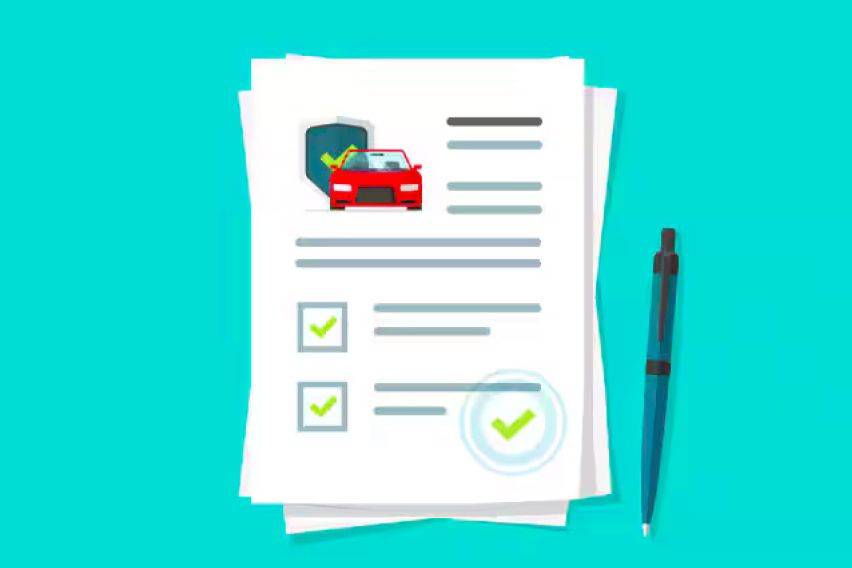
Is it essential to renew the registration after the 3-year period?
Yes or else you’ll be charged with several fines and penalties. Also, being a responsible citizen owning a motor vehicle, it is important to keep track of car registration renewal.
How to calculate registration renewal time?
So, to ease the process, LTO has formed a structured system that helps users understand when their vehicle is due for registration renewal. Knowing the countdown to the three years for renewal comes with its own set of benefits, including -
- Help plan vehicle registration well in advance
- Prevents vehicle owners from all the unnecessary expenses (fines and penalties)
In addition to the above-mentioned benefits, there are a few crucial reasons as well, including
Legal compliance: You can not drive a vehicle with expired registration on Philippine roads. This is a legal requirement, and not adhering to it will lead to fines, penalties, and even impoundment of the vehicle. So, it is better to be aware of when the valid years are ending.
Insurance requirement: A valid and up-to-date motor vehicle registration is a prerequisite for many insurance providers. Failure to renew registration impacts insurance coverage, which will leave you without any protection in case of an accident.
Smooth renewal: When a motor vehicle owner knows the registration validity period, he/she is able to plan the LTO visit for renewal in advance. This allows them to take care of all the paperwork and payments in a proper and timely manner, with no last-minute rush.
Proves vehicle’s roadworthiness: A registered vehicle signifies the fact that it has cleared all the LTO’s safety and emissions standards. And likewise a vehicle’s regular renewal continues to ensure the vehicles meet all the necessary government requirements.
Comes in handy at the time of accidents and violations: A registered vehicle with LTO is easier to trace at the time of an accident or violation.
LTO’s new rule around vehicle registration
Before we move forward to understand the procedure of counting the 3-year registration period, let us first have a look at the LTO’s 2023 released rule (Memorandum Circular No. JMT-2023-2395). According to the new rule book:
- The initial registration for new motorcycles (with engines of 200 cc and below) is valid for three years. Previously, the three-year validity was only limited to motorcycles with 201cc and above engine capacity

- Provisions for adjustments of the Motor Vehicle User’s Charge (MVUC), which is a fee collected by LTO during initial registration. The fee collected will now cover registration for not just one but three years for motorcycles with 200 cc or below engine.
Thus, motorcycle owners must now also learn how to count registration validity periods so that they do not face any fines or penalties for late renewal.
Also Read: Why timely OR CR renewal is essential for Filipino car owners?
Step-by-step guide to counting 3-year registration validity
When should I renew my motor vehicle registration? Many vehicle owners ask themselves this question so that they don’t have to pay a fine or penalty. Check out the step-by-step guide to find the answer yourself.
Step 1: Check out the vehicle’s registration date
A vehicle’s three-year registration period begins from the month of its purchase. Just remember this date, as it marks the starting point of the registration and also helps you count the years until renewal.
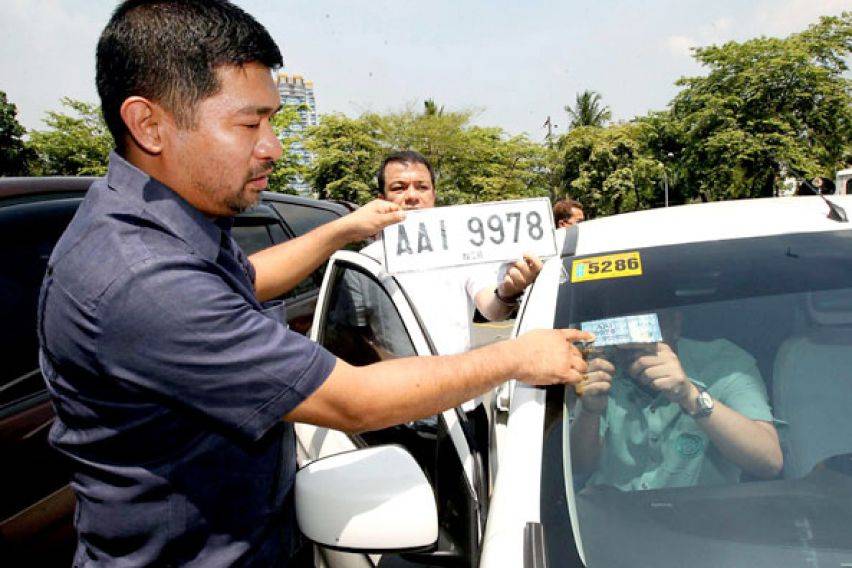
Step 2: Understand the plate number-based system
Did you know the last digit of your vehicle’s plate number signifies the registration renewal month? Well, here’s the table signifying the number and its corresponding renewal month.
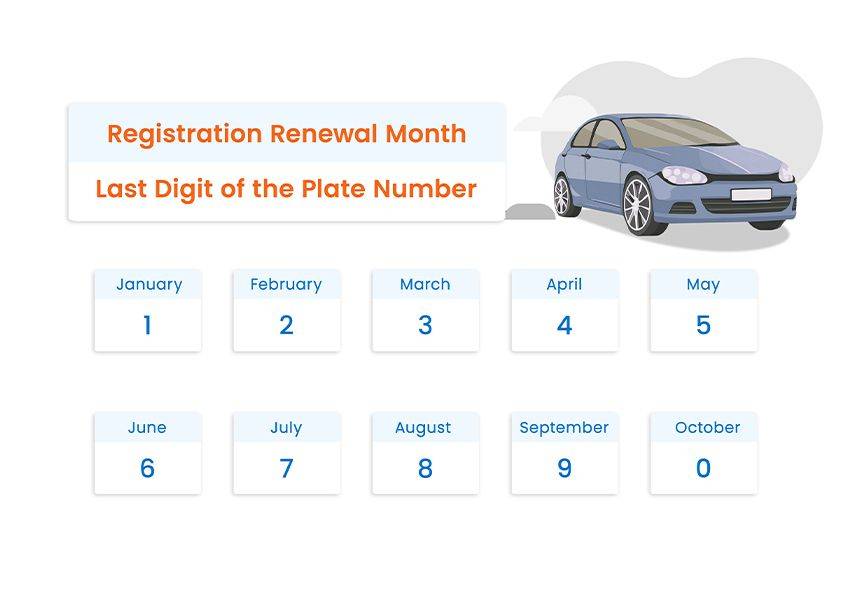
So, the vehicle registration renewal only takes place between January and October. Coming to the weekly deadline it corresponds with the second last digit of the plate number.
Step 3: Get the renewal deadline calculation right
The above-mentioned table will help you determine the vehicle registration renewal deadline right almost every time. So, for instance, if the last four digits of your plate number read 2376, then as per the above table the last digit, i.e, 6 corresponds to June, and the second-last digit, i.e., 7 corresponds to the 3rd week (15th-21st dates). Meaning you’d have to visit the LTO for registration renewal in the third week of June, obviously on a working day.
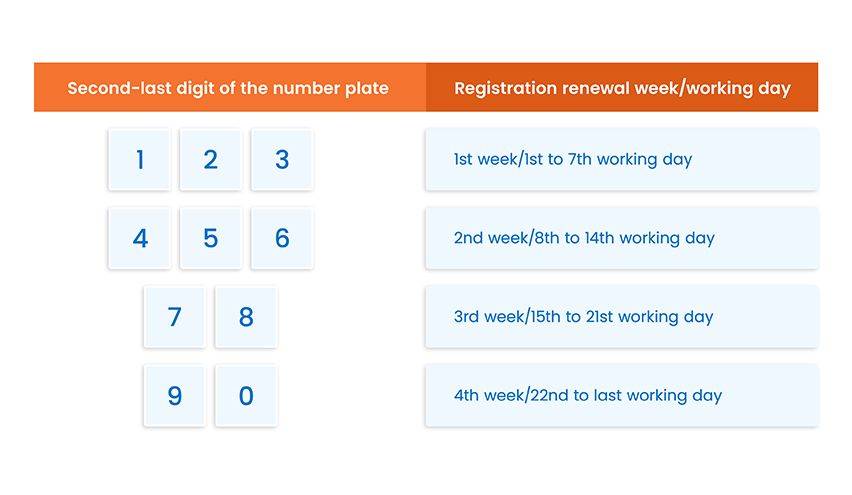
Here’s an example for better understanding -
Say you purchased your car and got it from the dealership on 1 May 2024. So, as per the LTO, the initial registration is valid for three years, meaning it is valid until May 2027. After this, you’ll need to visit the LTO or LTMS Portal for registration renewal. This is also the cue for registration renewal time for motor vehicles with no permanent plate number.
However, with a plate number you can specify the exact time frame (week and month) of the vehicle registration. Now, say the last two digits of your number plate are 27; then, as per LTO’s plate number system, the last digit specifies the month, and the second-last digit specifies the week of registration renewal (refer to the tables above). So, here, 2 corresponds to February, and 7 corresponds to the third week, i.e., any working day between 15 and 21. And since the car was purchased in 2024, the initial registration is valid till 2027. This means you’ll be heading to the LTO’s office of registration renewal on any working day between 15 to 21 Feb 2027.
In the above scenario, you won’t be required to pay the MVUC and registration fee as the initial registration is valid until May 2027 and will be renewed in February 2027. However, you’d still be required to deposit a small amount for the stickers.
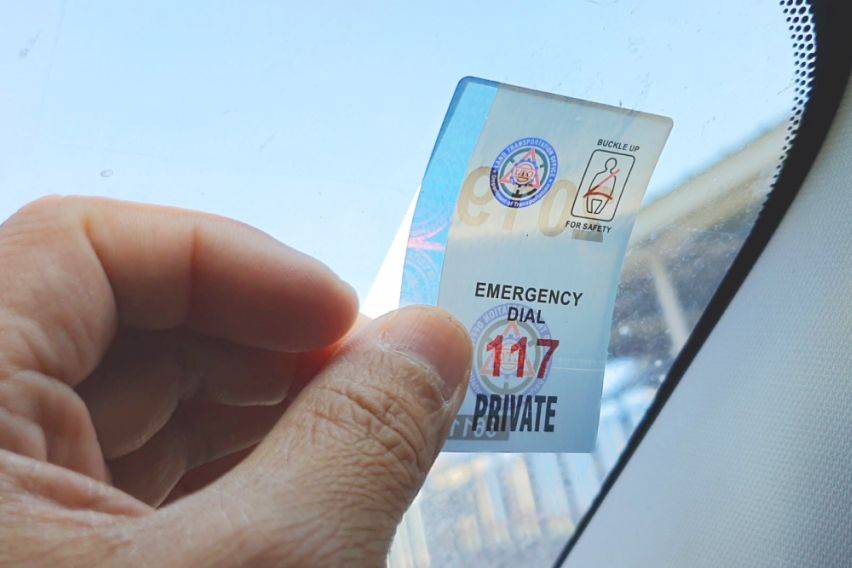
Step 4: Plan for renewal in advance
Now that you know when the vehicle’s registration is due for renewal, it’s time to plan everything well in advance. This will ensure a smooth renewal process and help you avoid fines and penalties.
Step 5: Check LTO’s notifications
It’s not like LTO has given you the formula to calculate the registration renewal date, and now it’s up to you to show up at the office and do what is necessary. In reality, LTO issues renewal reminders to vehicle owners, so keep track, guys.
Step 6: Collect all documents
A day before the registration renewal date, it is advisable to collect all the required documents. The list includes -
- Photocopy of Original Receipt of last registration
- Photocopy of Certificate of Registration (CR)
- Government authorised valid ID
- Tax Identification Number (TIN)
- Early warning device
- Original Copy of Certificate of Emission Compliance (CEC)
- Duly approved and accomplished Motor Vehicle Inspection Report (MVIR)
- Original LTO copy of Insurance Certificate of Cover (or electronically transmitted version)
While the above-mentioned requirements are a must, there are a few additional requirements depending on the type of vehicle.
- Tax-Exempt vehicle: Original Endorsement with control number
- Other exempt vehicle under Special Economic Zones: Original OEV (Other Exempt Vehicle) certification
- Vehicle used for rentals: Certified copy of the Valid Motorized Tricycle Operator’s Permit (MTOP) with Official Receipt, and Electronically transmitted franchised confirmation or Provisional Authority (PA) or petition for an extension of validity duly received by the LTFRB with OR
- Stolen and recovered vehicle: Original Certificate of re-stamping in case of tampered engine/chassis, Presentation of the original and submission of a photocopy of the Lifting of General Alarm, Presentation of the original and submission of a photocopy of the Report of Recovery, Presentation of the original and submission of a photocopy of the Alarm Sheet, and Original PNP Crime Laboratory (macro etching report) or National Bureau of Investigation (NBI) report
Step 7: Head to the LTO office
On the day of registration renewal, we’d advise you to arrive a bit early as it will help you skip the long queues. Once your name is called, get ready to submit the documents and pay the fee. The latter includes the initial registration fee (PHP 615) along with a renewal fee of PHP 400.
Step 8: Renewed certificate of registration
After the completion of all the formalities, submission of the documents, and payment of the fees, you’ll receive the renewed certificate of registration along with license plates. Before leaving the LTO office, make sure all the details mentioned are correct.
While the above-mentioned steps discuss the offline registration renewal process in detail, if you prefer not to spend long hours at the LTO office, there is another way around i.e., online registration renewal (we’ll discuss it soon).
Tips for LTO registration renewal
Here are a few essential tips that ease your registration renewal process -
- Do carry your LTO Client ID
- Try reaching LTO before 8:00 AM
- Your car will be inspected by officials, so make sure the car is in good running condition
- Officials may ask you to show an early warning device, so make sure to carry one along
- Carry loose change, a pen, and a source of entertainment (like a book)
- Make sure you don’t communicate with impersonators claiming to be LTO officials
Bottom line
Getting your vehicle’s registration renewed is necessary, and the process is not that difficult. All you need to do is trace the renewal time period, gather the necessary documents, and pay the required fee. While LTO does prompt notification to vehicle owners regarding the registration renewal, there's also a self-identifying process called the plate number-based system. With all this knowledge in hand, you can navigate through the registration renewal landscape with ease, avoiding unnecessary fines and penalties.
Also Read: Don't get caught off guard: A complete guide to car registration renewal in the Philippines
Featured Articles
- Latest
- Popular
Recommended Articles For You
Featured Cars
- Latest
- Upcoming
- Popular
Car Articles From Zigwheels
- News
- Article Feature
- Advisory Stories
- Road Test
